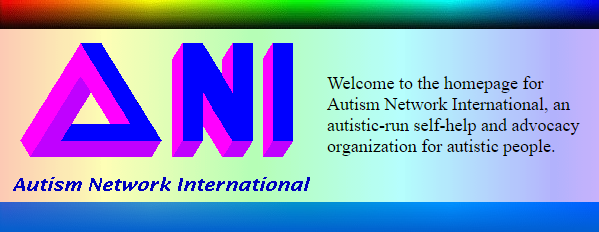Autism Network International
Australian and American activists then formed Autism Network International (ANI) in 1992, supplemented since 1994 by Autism Network International Listserv (ANI-L). The first issue of their newsletter Our Voice came out in 1992, and the first autistic retreat (called Autreat) took place in 1996 (Bagatell 2010, Chamak 2008, Orsini 2012, Silverman 2008a, Silberman 2015).
Although nonautistics may adhere to ANI, all decision making is done by autistics alone. The motto “By autistics for autistics” captures the network’s core values and expresses the principle of the disability movement at large, “Nothing about us without us” (Charlton 2000, Shapiro 1993). Their goal is to fight the vision of autism conveyed by professionals and families who share an “obsession” with a cure ANI considers not merely disrespectful of the autistic way of life but an attempt to erase legitimate difference. Hence the strength of the anti-cure attitude in this camp (Sinclair 2005).

Autism Network International: The Development of a Community and Its Culture
by Jim Sinclair,©January 2005
The American Heritage(r) Dictionary of the English Language (2000) defines "community" in part as: A group of people having common interests," "A group viewed as forming a distinct segment of society," "Similarity or identity" and "Sharing, participation, and fellowship." Its entries for "culture" include "The totality of socially transmitted behavior patterns, arts, beliefs, institutions, and all other products of human work and thought," "These patterns, traits, and products considered as the expression of a particular period, class, community, or population," and "The predominating attitudes and behavior that characterize the functioning of a group or organization."
Nearly all the operative terms in those definitions would seem to be at odds with the traditional view of autism as profound impairment in social functioning. Autistic people are seen as lacking the ability to share common interests with others, disconnected from social participation and fellowship, and inaccessible to social transmission of behaviors and attitudes. How, then, can we speak of autistic community and autistic culture?
This article will describe how one particular group of autistic people joined together on the basis of common interests, and grew into a community. Along the way I will tell you a bit about the culture that has developed within that community. It is my hope that through this introduction to my community, you will begin to reconsider many of the assumptions you may have about autistic social characteristics. Is it always correct to view differences between the behavior of autistics and NTs as "symptoms" of some "disorder" in autistic people? Is it necessarily helpful to respond to such differences by trying to teach autistic people to emulate NT social behaviors so they can "fit in" with NT culture? What alternatives might there be for addressing social difficulties between autistic and NT people? These are some questions you should ask yourself as you read this article.
Continue reading this article at the Autism Network International official website:
Autism Network International: The Development of a Community and Its Culture

Bagatell, Nancy. 2010. “From Cure to Community: Transforming Notions of Autism.” Ethos 38:33–55.
Chamak, Brigitte, et al. 2008. “What Can We Learn About Autism from Autistic Persons?” Psychotherapy...






































































0 comments
Sign in or create a free account